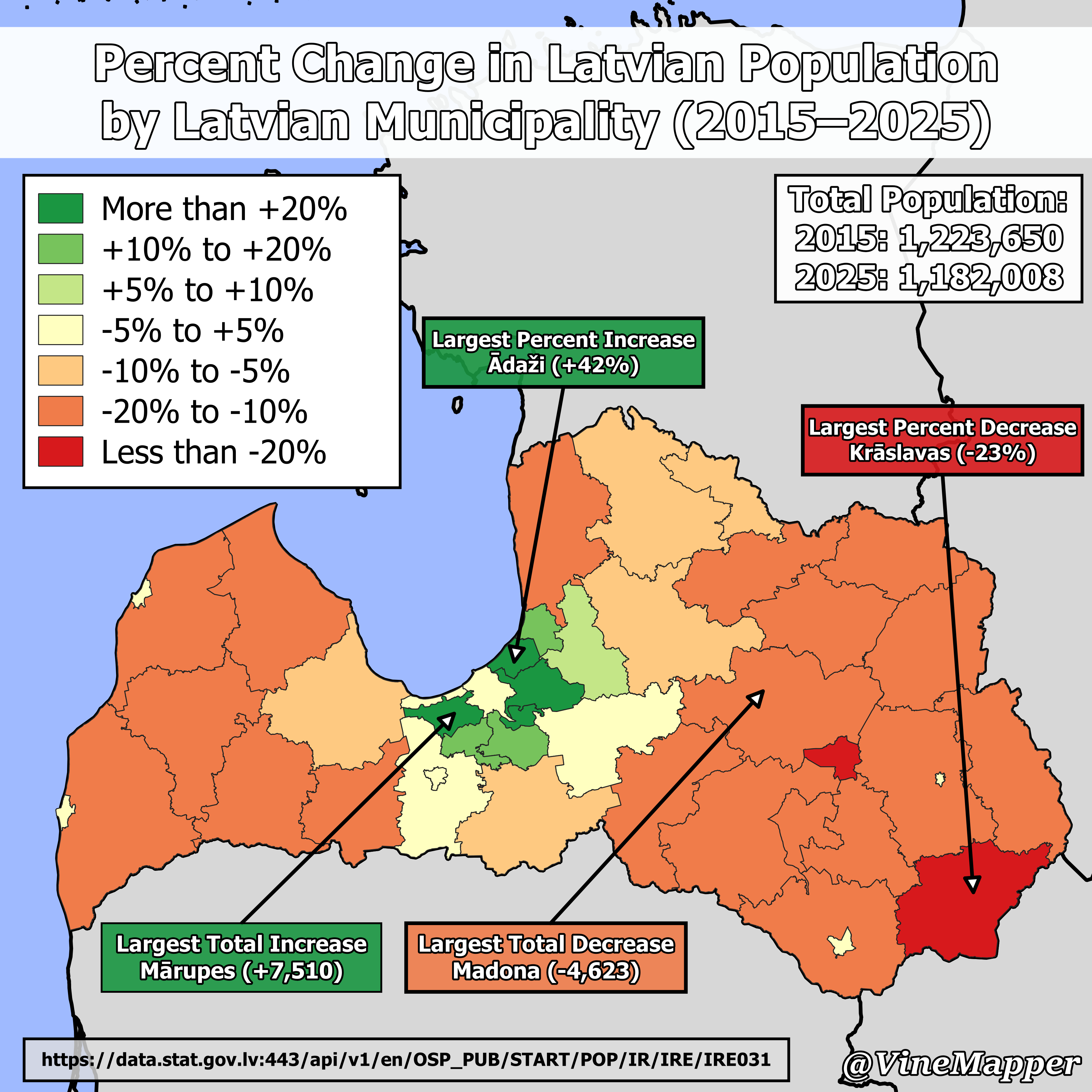Latvian Population Change by Municipality Map


Marcus Rodriguez
Historical Geography Expert
Marcus Rodriguez specializes in historical cartography and geographic data analysis. With a background in both history and geography, he brings unique...
Geographic Analysis
What This Map Shows
The "Percent Change in Latvian Population by Latvian Municipality (2015-2025)" map provides a detailed view of demographic shifts across various municipalities in Latvia over a decade. This visualization captures the percentage increase or decrease in population within each municipality, reflecting broader socio-economic trends and regional dynamics.
Transitioning from the visualization, let’s delve into the intriguing topic of population dynamics in Latvia, which is influenced by factors such as migration, birth rates, and economic opportunities.
Deep Dive into Population Dynamics in Latvia
Latvia, like many other European countries, has experienced significant demographic changes in recent years. The population dynamics are shaped by a cocktail of factors, including economic conditions, urbanization, and migration patterns. As of 2023, Latvia's population is approximately 1.9 million, a number that has fluctuated due to various influences, including the migration of Latvians abroad in search of better opportunities.
Interestingly, Latvia has one of the fastest-declining populations in the EU, with a notable decline in rural areas as younger generations migrate to urban centers or abroad. The map illustrates these trends vividly, showing municipalities like Rīga, the capital city, experiencing population growth, while rural municipalities such as Aizkraukle and Kuldīga are witnessing declines.
Migration plays a crucial role in these population shifts. Many Latvians have moved to Western Europe for work, leading to a net outflow of people. According to the Central Statistical Bureau of Latvia, between 2015 and 2020, around 50,000 people left the country, creating a noticeable impact on smaller municipalities. Conversely, Rīga, with its economic opportunities and higher education institutions, attracts a significant influx of people, contributing to its population growth.
Birth rates further compound these dynamics. Latvia's birth rate has been relatively low, similar to many countries in the region, which adds to the challenge of maintaining a stable population level. The total fertility rate in Latvia hovers around 1.6 children per woman, below the replacement level of 2.1. This statistic, coupled with the migration outflow, creates a demographic imbalance that has long-term implications for social services, workforce sustainability, and economic vitality.
Regional Analysis
Examining the map more closely reveals distinct regional patterns. For instance, municipalities like Rīga and Jūrmala show a positive percent change, emphasizing urban growth and the appeal of city life. Rīga, as the economic and cultural heart of Latvia, continually attracts residents due to its vibrant job market and educational institutions. Interestingly, Jūrmala, known for its beaches and resort facilities, also benefits from seasonal influxes, which can temporarily boost its population figures.
In contrast, municipalities such as Latgale and parts of Vidzeme reveal striking declines. Latgale, often associated with economic challenges and lower living standards, has seen a significant outflow of residents seeking opportunities elsewhere. For example, Daugavpils, once a bustling industrial town, has faced economic stagnation, leading to a negative population trend.
Moreover, municipalities in Zemgale, such as Bauska and Jūrmala, also reflect mixed trends, with some areas gaining residents while others continue to lose population. The divergence within regions often correlates with local economic conditions and the availability of jobs, education, and healthcare services.
Significance and Impact
Why does understanding population change matter? The implications are profound. Population dynamics influence labor markets, healthcare demands, and even political representation. A declining population can lead to labor shortages, impacting economic growth and innovation. Moreover, areas experiencing population loss may struggle to maintain infrastructure and services, leading to a vicious cycle of decline.
Looking to the future, the forecast suggests that Latvia will continue to grapple with these demographic challenges. Policymakers must address issues such as youth migration, support for families to increase birth rates, and strategic urban planning to accommodate population growth in key areas while revitalizing those that are declining.
In conclusion, the "Percent Change in Latvian Population by Latvian Municipality (2015-2025)" map not only visualizes demographic shifts but also serves as a critical tool for understanding the underlying factors driving these changes. By analyzing these trends, we gain insights into the future of Latvia's socio-economic landscape and the challenges that lie ahead.
Visualization Details
- Published
- August 8, 2025
- Views
- 104
Comments
Loading comments...